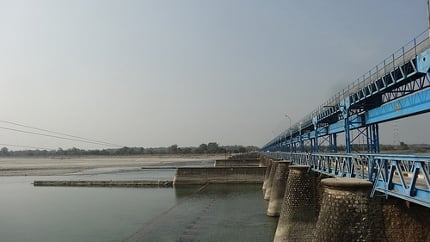Last June, a flood in the Mahakali river – which marks a part of Nepal’s western border with India – swept away almost half of Khalanga Bazaar, a town that is the headquarters of Nepal’s Darchula district. The cause of the flood is still a debate. Most locals blame Indian officials, alleging that they opened the gates of the Dhauliganga dam upstream. This has been consistently denied by India. Nepal government officials have kept quiet.
With four months left until the next monsoon, residents of Darchula are afraid. They see very little river management work by the Nepal government, while India is rapidly building a dyke to keep floodwaters away from its banks.
“We can see the construction work from Khalanga, but our government has nothing to say. We informed our authorities about this but our voice is not heard,” said Lalit Singh Bohara, president of the Flood Victims Struggle Committee of Khalanga. Last year’s flood victims have not yet received compensation from Nepal government and have been protesting. “We will restart our protest next month from Kathmandu as the new government has just been formed,” Bohara added.
Locals have complained that due to the construction of dykes and embankments by India, water gets diverted towards Nepal and this has been going on for years. “India has always been dominant and never been serious about our problems. We have no option but to live life as it comes,” said Bharat Chand, a journalist based in Khalanga.
At a conference earlier this week in Kathmandu, one of the government officials from the Water and Energy Commission Secretariat (WECS) under the Ministry of Energy that deals with water resources said that he is quite sure that the flood happened because the Indian side opened the gates of Dhauliganga dam to release water. “It’s obvious but India always denies [it] and Nepal can’t express the reality due to political reasons,” said the official, who did not want to be identified.
“India is doing construction because they want to save their people. What about our government? We are waiting to die and no construction works have even started on the Nepal side,” Bohara complained.
The Nepal government has also invited tenders for the construction of dykes on its side of the Mahakali river and work will start soon. “Bidding has already been opened for Rs 550 million (US$5.5 million) and is under process,” said an official at the Department of Water Induced Disaster Prevention, Ministry of Irrigation.
Disputes between India and Nepal on the construction of dams and dykes have become routine. Many residents of Nepal feel that Indian officials do not care about the problems on the Nepal side of a shared river.
However, in recent floods, there has been huge loss of lives and property on the Indian side too. Independent experts say this is due to lack of trust between policymakers of the two countries

